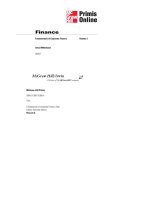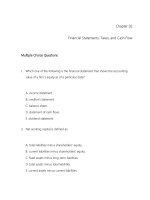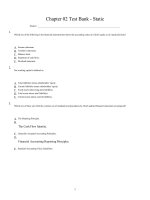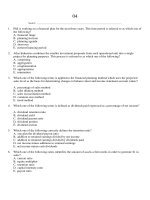Lecture Fundamentals of corporate finance: Lecture 4 - Ross, Westerfield, Jordan
Bạn đang xem bản rút gọn của tài liệu. Xem và tải ngay bản đầy đủ của tài liệu tại đây (1.05 MB, 22 trang )
Lecture 4
Discounted Cash
Flow Valuation
© 2003 The McGrawHill Companies, Inc. All rights reserved.
6.2
Lecture Outline
• Valuing Level Cash Flows: Annuities and
Perpetuities
• Comparing Rates: The Effect of
Compounding Periods
• Loan Types and Loan Amortization
McGrawHill/Irwin
© 2003 The McGrawHill Companies, Inc. All rights reserved.
6.3
Annuities and Perpetuities Defined
• Annuity – finite series of equal payments that
occur at regular intervals
– If the first payment occurs at the end of the period,
it is called an ordinary annuity
– If the first payment occurs at the beginning of the
period, it is called an annuity due
• Perpetuity – infinite series of equal payments
McGrawHill/Irwin
© 2003 The McGrawHill Companies, Inc. All rights reserved.
6.4
Annuities and Perpetuities – Basic Formulas
• Perpetuity: PV = C / r
• Annuities:
1
PV
FV
McGrawHill/Irwin
C
C
(1
1
(1 r ) t
r
r )t
r
1
© 2003 The McGrawHill Companies, Inc. All rights reserved.
6.5
Annuity – Sweepstakes Example
• Suppose you win the Publishers
Clearinghouse $10 million sweepstakes. The
money is paid in equal annual installments of
$333,333.33 over 30 years. If the appropriate
discount rate is 5%, how much is the
sweepstakes actually worth today?
– PV = 333,333.33[1 – 1/1.0530] / .05 =
5,124,150.29
McGrawHill/Irwin
© 2003 The McGrawHill Companies, Inc. All rights reserved.
6.6
Buying a House
• You are ready to buy a house and you have $20,000
for a down payment and closing costs. Closing costs
are estimated to be 4% of the loan value. You have
an annual salary of $36,000 and the bank is willing to
allow your monthly mortgage payment to be equal to
28% of your monthly income. The interest rate on the
loan is 6% per year with monthly compounding (.5%
per month) for a 30year fixed rate loan. How much
money will the bank loan you? How much can you
offer for the house?
McGrawHill/Irwin
© 2003 The McGrawHill Companies, Inc. All rights reserved.
6.7
Buying a House - Continued
• Bank loan
– Monthly income = 36,000 / 12 = 3,000
– Maximum payment = .28(3,000) = 840
– PV = 840[1 – 1/1.005360] / .005 = 140,105
• Total Price
– Closing costs = .04(140,105) = 5,604
– Down payment = 20,000 – 5604 = 14,396
– Total Price = 140,105 + 14,396 = 154,501
McGrawHill/Irwin
© 2003 The McGrawHill Companies, Inc. All rights reserved.
6.8
Annuities on the Spreadsheet - Example
• The present value and future value formulas in
a spreadsheet include a place for annuity
payments
• Click on the Excel icon to see an example
McGrawHill/Irwin
© 2003 The McGrawHill Companies, Inc. All rights reserved.
6.9
Finding the Payment
• Suppose you want to borrow $20,000 for a
new car. You can borrow at 8% per year,
compounded monthly (8/12 = .66667% per
month). If you take a 4 year loan, what is your
monthly payment?
– 20,000 = C[1 – 1 / 1.006666748] / .0066667
– C = 488.26
McGrawHill/Irwin
© 2003 The McGrawHill Companies, Inc. All rights reserved.
6.10
Finding the Payment on a Spreadsheet
• Another TVM formula that can be found in a
spreadsheet is the payment formula
– PMT(rate,nper,pv,fv)
– The same sign convention holds as for the PV and
FV formulas
• Click on the Excel icon for an example
McGrawHill/Irwin
© 2003 The McGrawHill Companies, Inc. All rights reserved.
6.11
Finding the Number of Payments
• Suppose you borrow $2000 at 5% and you are
going to make annual payments of $734.42.
How long before you pay off the loan?
–
–
–
–
–
2000 = 734.42(1 – 1/1.05t) / .05
.136161869 = 1 – 1/1.05t
1/1.05t = .863838131
1.157624287 = 1.05t
t = ln(1.157624287) / ln(1.05) = 3 years
McGrawHill/Irwin
© 2003 The McGrawHill Companies, Inc. All rights reserved.
6.12
Annuity – Finding the Rate
• Trial and Error Process
– Choose an interest rate and compute the PV of
the payments based on this rate
– Compare the computed PV with the actual loan
amount
– If the computed PV > loan amount, then the
interest rate is too low
– If the computed PV < loan amount, then the
interest rate is too high
– Adjust the rate and repeat the process until the
computed PV and the loan amount are equal
McGrawHill/Irwin
© 2003 The McGrawHill Companies, Inc. All rights reserved.
6.13
Future Values for Annuities
• Suppose you begin saving for your retirement
by depositing $2000 per year in an IRA. If the
interest rate is 7.5%, how much will you have
in 40 years?
– FV = 2000(1.07540 – 1)/.075 = 454,513.04
McGrawHill/Irwin
© 2003 The McGrawHill Companies, Inc. All rights reserved.
6.14
Annuity Due
• You are saving for a new house and you put
$10,000 per year in an account paying 8%.
The first payment is made today. How much
will you have at the end of 3 years?
– FV = 10,000[(1.083 – 1) / .08](1.08) = 35,061.12
McGrawHill/Irwin
© 2003 The McGrawHill Companies, Inc. All rights reserved.
6.15
Annuity Due Timeline
0 1 2 3
10000 10000 10000
32,464
35,016.12
McGrawHill/Irwin
© 2003 The McGrawHill Companies, Inc. All rights reserved.
6.16
Perpetuity – Example 6.7
• Perpetuity formula: PV = C / r
• Current required return:
– 40 = 1 / r
– r = .025 or 2.5% per quarter
• Dividend for new preferred:
– 100 = C / .025
– C = 2.50 per quarter
McGrawHill/Irwin
© 2003 The McGrawHill Companies, Inc. All rights reserved.
6.17
Effective Annual Rate (EAR)
• This is the actual rate paid (or received) after
accounting for compounding that occurs during the
year
• If you want to compare two alternative investments
with different compounding periods you need to
compute the EAR and use that for comparison.
McGrawHill/Irwin
© 2003 The McGrawHill Companies, Inc. All rights reserved.
6.18
Annual Percentage Rate
• This is the annual rate that is quoted by law
• By definition APR = period rate times the
number of periods per year
• Consequently, to get the period rate we
rearrange the APR equation:
– Period rate = APR / number of periods per year
• You should NEVER divide the effective rate
by the number of periods per year – it will
NOT give you the period rate
McGrawHill/Irwin
© 2003 The McGrawHill Companies, Inc. All rights reserved.
6.19
Computing APRs
• What is the APR if the monthly rate is .5%?
– .5(12) = 6%
• What is the APR if the semiannual rate is .
5%?
– .5(2) = 1%
• What is the monthly rate if the APR is 12%
with monthly compounding?
– 12 / 12 = 1%
– Can you divide the above APR by 2 to get the
semiannual rate? NO!!! You need an APR
based on semiannual compounding to find the
semiannual rate.
McGrawHill/Irwin
© 2003 The McGrawHill Companies, Inc. All rights reserved.
6.20
Things to Remember
• You ALWAYS need to make sure that the
interest rate and the time period match.
– If you are looking at annual periods, you need
an annual rate.
– If you are looking at monthly periods, you
need a monthly rate.
• If you have an APR based on monthly
compounding, you have to use monthly
periods for lump sums, or adjust the interest
rate appropriately if you have payments other
than monthly
McGrawHill/Irwin
© 2003 The McGrawHill Companies, Inc. All rights reserved.
6.21
Computing EARs - Example
• Suppose you can earn 1% per month on $1 invested
today.
– What is the APR? 1(12) = 12%
– How much are you effectively earning?
• FV = 1(1.01)12 = 1.1268
• Rate = (1.1268 – 1) / 1 = .1268 = 12.68%
• Suppose if you put it in another account, you earn 3%
per quarter.
– What is the APR? 3(4) = 12%
– How much are you effectively earning?
• FV = 1(1.03)4 = 1.1255
• Rate = (1.1255 – 1) / 1 = .1255 = 12.55%
McGrawHill/Irwin
© 2003 The McGrawHill Companies, Inc. All rights reserved.
6.22
Table 6.2
McGrawHill/Irwin
© 2003 The McGrawHill Companies, Inc. All rights reserved.









